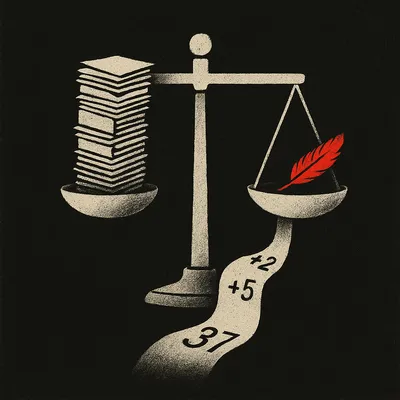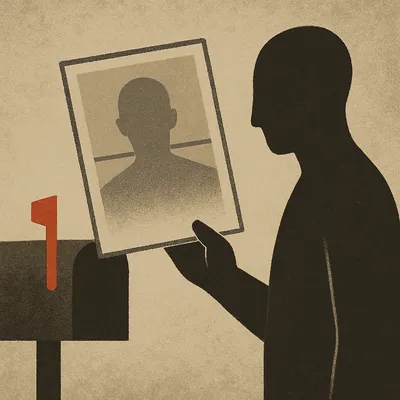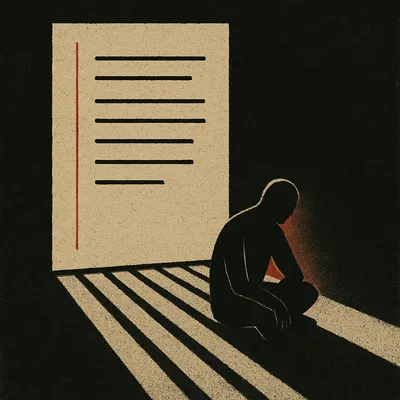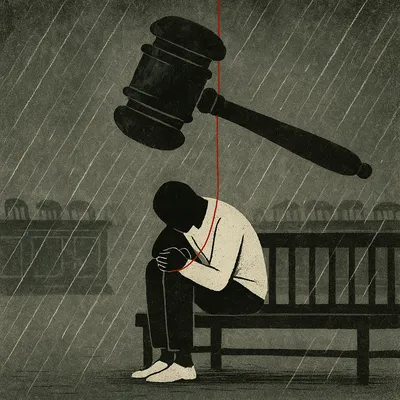Sentencing Disparity: Why CP Crimes Get Harsher Punishment Than Contact Offenses
A report by federal public defender Troy Stabenow called “Deconstructing the Myth of Careful Study: A Primer on the Flawed Progression of the Child Pornography Guidelines” traces the evolution of federal sentencing guidelines for CP cases from 1987 to present. The report reveals how congressionally mandated changes—driven by fear and misinformation rather than empirical evidence—have led to CP sentences that are as much as 567% longer than those for contact offenses.
To illustrate this progression, I’ve recalculated my own sentence based on guideline revisions over the past two decades.
Federal Sentencing Framework
The Sentencing Commission
The United States Sentencing Commission was created by Congress under the Sentencing Reform Act of 1984 as an independent entity within the judicial branch. The Commission develops and maintains the Federal Sentencing Guidelines to establish uniform sentences across federal prosecutions.
How Federal Sentences Are Calculated
Federal sentences are determined using two components: the total offense level and the defendant’s criminal history category. The offense level starts with a base level for the crime and adds or subtracts points based on specific characteristics. Criminal history points depend on prior convictions and their severity.
Under current guidelines, my offense level is 37 points—translating to 210-262 months imprisonment. This range exceeds the 20-year statutory maximum for transportation of child pornography under 18 U.S.C § 2252A(a)(2), capping my sentence at 20 years.
Judicial Discretion
Until 2004, judges were mandated to sentence within the Federal Sentencing Guidelines’ prescribed ranges. This changed in 2005 with the landmark Supreme Court decision in United States v. Booker, which ruled that mandatory guidelines violated defendants’ Sixth Amendment right to trial by jury. Thereafter, the guidelines became advisory rather than mandatory, with judges now reviewing sentences for “reasonableness” while retaining discretion to depart from guideline recommendations.
This shift has been significant for child pornography cases in particular. By 2007, 33% of defendants in these cases received sentences below the guideline ranges, reflecting judicial concerns about the guidelines’ proportionality and fairness.
The Evolution of Sentencing Guidelines
Initial Guidelines (April 1987)
When the federal guidelines were first adopted in April 1987, simple possession of child pornography wasn’t yet criminalized. The guidelines (§ 2G2.2) only covered transportation, receipt, and trafficking.
Had I been sentenced under these original 1987 guidelines, my offense would have totaled 13 points, resulting in 12-18 months imprisonment.
| § 2G2.2: Transportation, Receipt, and Trafficking (April 30, 1987) | |
|---|---|
| Base Offense Level | 13 |
| Minor under 12 years | +2 |
| Distribution < $100,000 in value | +5 |
| Acceptance of responsibility | -3 |
| Total Offense Level | 13 |
Criminalizing Possession (November 1991)
After Congress criminalized possession on November 29, 1990, the Commission created a new guideline (§ 2G2.4) for possession-related offenses while modifying § 2G2.2 to apply only to selling and intent to sell.
The Commission also enhanced penalties for material portraying “sadistic or masochistic conduct” and recommended upward departures for defendants with histories of sexually abusing children.
| § 2G2.2: Selling or Possessing with Intent to Sell (November 1, 1991) | |
|---|---|
| Base Offense Level | 13 |
| Minor under 12 years | +2 |
| Distribution < $100,000 in value | +5 |
| Material portraying sadistic conduct | +4 |
| Acceptance of responsibility | -3 |
| Total Offense Level | 16 |
Political Intervention Creates Disparities (November 27, 1991)
The Commission’s carefully structured guidelines were short-lived. Senator Jesse Helms, mistakenly believing the new guidelines reduced sentences, introduced Amendment 780 to reassign receipt back to § 2G2.2 alongside trafficking offenses, while simple possession remained under § 2G2.4.
This created a fundamental problem: since one can’t possess material without first receiving it, defendants with no intent to traffic could be sentenced under harsher guidelines intended for more serious offenses.
Despite the Commission’s warning that this would “reintroduce sentencing disparity among similar defendants and render the guidelines susceptible to plea bargaining manipulation,” the amendment passed after minimal discussion.
| § 2G2.2: Trafficking, Receipt, and Related Offenses (November 27, 1991) | |
|---|---|
| Base Offense Level | 15 |
| Minor under 12 years | +2 |
| Distribution < $100,000 in value | +5 |
| Material portraying sadistic conduct | +4 |
| Pattern of Abuse | +5 |
| Acceptance of responsibility | -3 |
| Total Offense Level | 18 |
Computer Use Enhancement (November 1996)
In 1995, Congress passed the Sex Crimes Against Children Protection Act, increasing base offense levels and adding a two-level enhancement for computer use. This enhancement was originally intended to target widespread distribution of material, but would eventually be applied to almost all cases regardless of scale.
| § 2G2.2: Trafficking and Related Offenses (November 1, 1996) | |
|---|---|
| Base Offense Level | 17 |
| Minor under 12 years | +2 |
| Distribution < $100,000 in value | +5 |
| Material portraying sadistic conduct | +4 |
| Pattern of Abuse | +5 |
| Computer use | +2 |
| Acceptance of responsibility | -3 |
| Total Offense Level | 22 |
Distribution Tiering (November 2000)
Following the Commission’s 1996 report, Congress passed the Protection of Children from Sexual Predators Act of 1998, directing the Commission to modify the “distribution” enhancement with varying penalties based on purpose and audience.
| § 2G2.2: Trafficking and Related Offenses (November 1, 2000) | |
|---|---|
| Base Offense Level | 17 |
| Minor under 12 years | +2 |
| Distribution (various types) | +2 to +7 |
| Material portraying sadistic conduct | +4 |
| Pattern of Abuse | +5 |
| Computer use | +2 |
| Acceptance of responsibility | -3 |
| Total Offense Level | 27 |
The Protect Act (April 2003 - November 2004)
The most consequential changes came via the Protect Act in 2003. The “Feeney Amendment,” inserted by a novice congressman at the behest of Justice Department attorneys, directly modified guidelines without Commission input or empirical justification.
The amendment:
- Added enhancements based on number of images
- Added the “sadistic or masochistic” enhancement to possession offenses
- Raised mandatory minimums and statutory maximums
- Prohibited the Commission from creating new downward departure guidelines
In 2004, the Commission increased base offense levels to match the statutory minimums and consolidated § 2G2.4 into § 2G2.2.
| § 2G2.2 (Consolidated) (November 1, 2004) | |
|---|---|
| Base Offense Level (Possession) | 18 |
| Base Offense Level (Trafficking) | 22 |
| Minor under 12 years | +2 |
| Distribution (various types) | +2 to +7 |
| Material portraying sadistic conduct | +4 |
| Pattern of Abuse | +5 |
| Computer use | +2 |
| Number of images (10 to 600+) | +2 to +5 |
| Acceptance of responsibility | -3 |
| Total Offense Level | 37 |
The Resulting Disparity
The severity of punishment for child pornography offenses increased dramatically across the federal system from 1987 to 2004, as illustrated by the corresponding rise in my own potential sentence:
| Guideline Revision | Total Offense Level | Sentence in Months |
|---|---|---|
| April 1987 | 13 | 12-18 |
| November 1991 | 16 | 21-27 |
| November 1991 (Helms) | 18 | 27-33 |
| November 1996 | 22 | 41-51 |
| November 2000 | 27 | 70-87 |
| April 2003 | 32 | 121-151 |
| November 2004 | 37 | 210-262 |
Fundamental Problems
Today’s guidelines create several serious problems:
- First-time offenders routinely reach statutory maximums. With 97% of cases involving computer use and enhancements for number of images easily reached, first-time offenders often receive maximum sentences.
- No differentiation between first-time and repeat offenders. When first-time offenders already reach the statutory maximum, the guidelines fail at their core purpose of providing proportionately harsher penalties for those with criminal histories.
- Non-contact offenses receive harsher sentences than contact offenses. Most disturbing is that possession of child pornography now carries sentences exceeding those for actual sexual assault of children.
As Stabenow illustrates, a hypothetical case of a 50-year-old man who grooms and repeatedly sexually assaults a 13-year-old girl would receive a guideline range of just 37-46 months after acceptance of responsibility.
My calculated sentence for trading pornography is 567% higher than the sentence given to someone who physically abuses a child.



